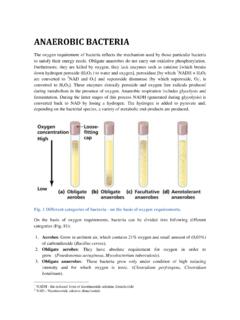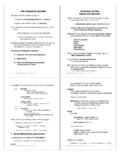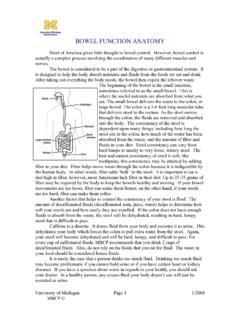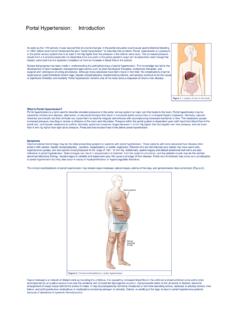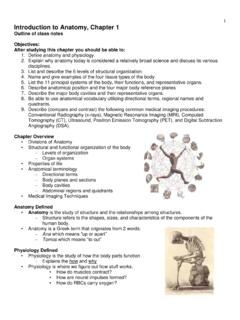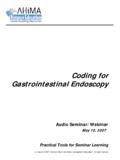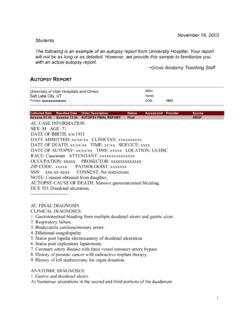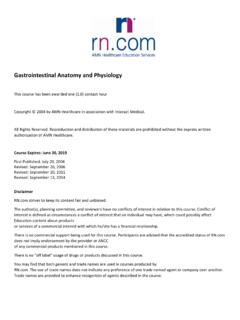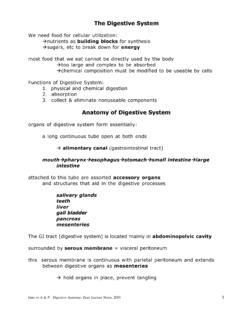Transcription of PHYSIOLOGY OF THE GASTROINTESTINAL TRACT (GIT)
1 1 PHYSIOLOGY OF THE GASTROINTESTINAL TRACT (GIT) Main function: The GIT provides the body with a supply of water, nutrients, electrolytes, vitamines. Actions: 1) Digestion of the food 2) Absorption of the products of digestion Ad 1) Digestive processes: - mechanical - chemical Mechanical methods: - mastication (chewing) - swallowing (deglutition) - movements of the GIT (motor functions) Chemical means (secretions): - saliva - gastric juice - pancreatic juice - intestinal juice - bile PHYSIOLOGY OF MOUTH Functions: 1/ Mechanical and chemical digestion of the food 2/ The source of the unconditioned reflexes 3/ Control of physical and chemical properties of the food Ad 1 a Mechanical activity mastication The anterior teeth a cutting action The posterior teeth a grinding action Thee maximal closing force - incissors 15 kg - mollars 50 kg Inervations of the muscles of chewing 5th, 8th, 12th cranial nerves Centers near the brain stem and cerebral cortex centers for taste Act of mastication: The movement of the lower jaw down: - Contraction of m.
2 Biventer mandibulae ( ), m. pterygoideus ext., infrahyoidei The movement up: the drop initiates a stretch reflex Contraction of m. masseter, m. temporalis, m. pterygoideus Rebound of antagonists- inhibition the jaw drops + compression of the bolus of the food against the linings of the mouth - rebound repetitive Mastication reflexive and voluntary Function of the mastication: - grinding the food - mixing with saliva - prevention of excoriation of GIT - makes easy swalowing 2 - aids subsequent digestion SALIVATION Ad 1 b) Adjustment of the food by the saliva The salivary glands: - parotid - submandibular - sublingual - buccal Secretion of the saliva: - basal - 800 1500 ml/day - during intake of food Regulation of salivary secretion nervous - parasympathetic - sympathetic Unconditioned reflexes: Taste and tactile stimuli increase 8-20 times the basal rate of secretion Conditioned reflexes: Visual, olphactoric, acoustic stimuli Centers: salivatory nuclei (at the juncture of the medulla and pons): superior submandibular (70%), sublingual (5%) inferior parotid (serous saliva) Parasympathetic nerves: , stimulation of the salivation.
3 Parasympathetic nerves acetylcholine kallikrein alpha 2 globuline (plasma) bradykinine vasodilatation stimulation of the secretion of saliva (serous) Sympathetic nerves: stimulation of the secretion of the mucinous saliva Composition of the saliva % - water; % substances organic % - anorganic % Organic substances: Mucin, digestive enzymes ptyalin, lingual lipase, proteolytic enzymes, cytochromoxidase, carbanhydrase, phosphatase, IgA, lysozyme, blood groups Cells: leukocytes,epithelial cells,.. Anorganic substances: Na+, K+, Cl-, HCO3- Functions of saliva Saliva - keeps the mouth moist, aids speech - facilitates swallowing - serves as a solvent for the molecules that stimulate the taste buds - serves a solvent for irritating foods - helps wash away the pathogenetic bacteria, - destroy bacteria (thiocyanate ions, proteolytic enzymes),by proteins antibodies 3 can destroy oral bacteria, lysozyme = antibacterial - keeps the mouth and teeth clean Deficient salivation = xerostomia Swallowing (Deglutition) Three stages.
4 1) oral voluntary the food is squeezed into the pharynx by tongue 2) pharyngeal automatic cannot be stopped (1 s) Involuntary contraction in the pharyngeal muscles that pushes the food into the oesophagus. Concomitant actions: Inhibition of respiration, closing of the posterior nares by the soft palate, pulling the larynx upward (enlargement the opening of the oesophagus), glottic closure Control of the pharyngeal stage of swallowing -swallowing reflex: Swallowing center in the medulla and lower pons Afferent nerves Vth, VIIth, IXth, Xth Coordination of the swallowing with respiration 3) oesophageal stage of swallowing: Oesophagus - the first third striated muscle - the last third smooth muscle - the middle mixed Innervation n. vagus, sympathetic nerves and others endings Function to transport food from the pharynx to the stomach by gravity and by peristalsis Peristalsis primary = a continuation of the peristaltic wave from pharynx - secondary waves result from distention of the oesophagus by the retained food.
5 Speed 4 cm/s The swallowing time for a compact food 6-9 s a fluid 4-5 s Regulation of the oesophageal peristalsis: - by intrinsic neural circuits myenteric and submucosal plexus - by vagal efferent fibers Functions of the upper and lower oesophageal sphincters Upper pharyngoesophageal junction 3 cm segment with high resting tone relaxes reflexly upon swallowing Lower cardia sphincter cardiae 2-5 cm above the juncture of the oesophagus with the stomach. Circular muscle tonically constricted. Receptive relaxation allows propulsion of the swallowed food into the stomach. The relaxation through VIP. Disorders of the swallowing: - dysphagia pain 4 - achalasia weak oesoph. peristalsis, accumulation of the food in the oesophagus dilatation, increased tonus of cardiae. Pneumatic dilatation or myotomy - lower oes.
6 Sphincter incompetence gastrooesophageal reflux (GER). Surgical treatment. STOMACH anatomy and histology - Cardia - Fundus - Corpus - Antrum - Pyloric sphincter The smooth layers: - longitudinal ext. - circular - med. - transversal - int. Each muscle layer functions as a syncytium gap junctions Innervation: - myenteric plexus outer between the longitudinal and circular layers - submucosal plexus inner Vagal and sympathetic control Gastric motility The motor functions of the stomach: 1) storage of food 2) mixing " with gastric secretions semifluid form chyme 3) emptying of the food into duodenum 1) Storage: receptive relaxation of the stomach (P = 6 mmHg) by - a plasticity of the smooth muscle layers - nervous action reduction of vagal tone - humorally (gastrin) Food forms concentric circles.
7 A limit about l. Storage time: Fats 6 hours, proteins 4 hours, sacharides 2 hours 2) Mixing: Gastric slow waves basal electric rhythm 3/min pacemaker cells the circular smooth muscle of the fundus Velocity 1- 4 cm/s weak propulsion to move the chyme toward the antrum. Raising intensity peristaltic constrictor rings. Hunger contractions when the stomach is empty fora long time (12 hours ..) intensive contractions most intense in young people feeling of hunger regulation of the food intake. 5 3) emptying of the stomach Antral peristaltic contractions P 50-70 mmHg pressure against the pylorus. Pylorus circular muscle sphincter receptive relaxation - after passage of a bolus contraction pyloric pump. Regulation of the emptying: - Stretching of the stomach wall peristalsis inhibits the pylorus - Gastrin stimulates gastric motility.
8 Acid in the antrum (G-cells) inhibits gastrin secretion a negative feedback. It enhances the activity of the pyloric pump. - Duodenal factors: Enterogastric reflex distention of the duodenum, activity of duodenal osmoreceptors inhitition in gastric motility through the enteric nervous system Hormonal feedback the stimulus mainly fats in the duodenum hormones: GIP, CCK a competitive inhibitor of the gastrin Disturbances of the gastric emptying Pylorostenosis congenital hypertrophy of the circular layer. Incidence 1:200- boys, 1:800-girls Symptoms vomiting metabolic alkalosis, dehydratation Treatment surgical myotomy Pylorospasm functional hyperexcitability of parasympathetics. Symptoms like pylorostenosis Treatment anticholinergic drugs (atropine) V o m i t i n g Expulsion of the gastric gut contents through oesophagus and mouth/nose out.
9 Vomiting: - peripheral - central 1) Peripheral: protective reflex against: - a presence of irritants in the GIT - an overdistention of GIT The most sensitive portion duodenum 2) Central: effect of some drugs (emetic) apomorphine, emetin, nikotine, digoxine or hypoxia, ischemia, bacterial endotoxines on the cells of the chemoreceptor trigger zone (near the area postrema). Psychic influences. The vomiting centre CNS RF lies near the tractus solitarius The vomiting act Nausea subjective feeling a necessity to vomit, pale, sweating, salivation hyperactivity of the autonomic nervous system Antiperistalsis of the small intestine, pyloroconstriction, stomach is relaxed. The vomiting act: 1) a deep inspiratory breath 2) closing of the glottis 3) lifting of the soft palate 6 4) strong downward contraction of the diaphragm along with contraction of all the abdominal muscles squeezing the stomach, intragastric P to a high level.
10 5) Contraction of the stomach, relaxation of the lower oes. sphincter expulsion of the gastric content through a passive oesophagus. Complications alkalosis, dehydration .. Gastric secretion 3 l of gastric juice daily Components: - Hydrochloric acid (HCl) parietal cells - Pepsinogens pepsins chief cells - Lipase - Intrinsic factor parietal cells - Mucus neck cells 1) Hydrochloric acid secretion Acid solution containing 150-160 mmols/l, pH = a) Cl- is actively transported from the cytoplasm of the parietal cells into the lumen of canaliculus b) H2O is dissociated into hydrogen and hydroxyl ions in the cell cytoplasm. H+ ions are actively secreted into the canaliculus in exchange for potassium ions.



